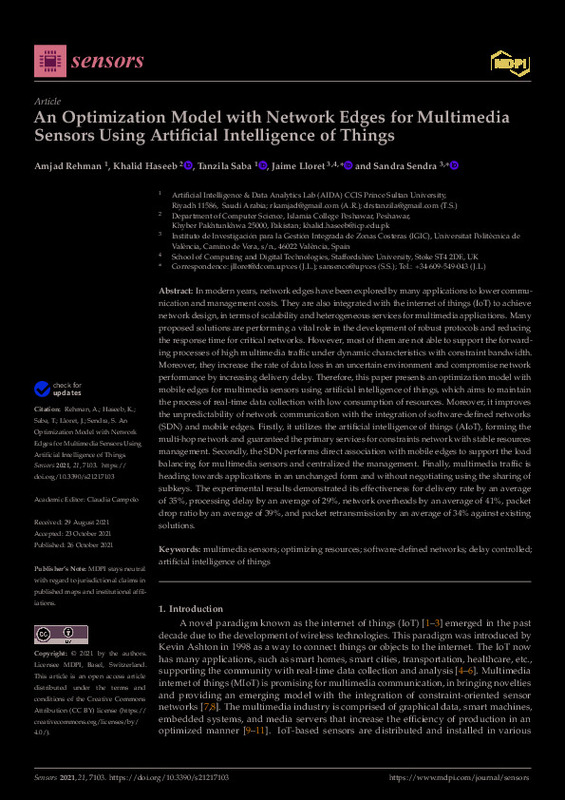JavaScript is disabled for your browser. Some features of this site may not work without it.
Buscar en RiuNet
Listar
Mi cuenta
Estadísticas
Ayuda RiuNet
Admin. UPV
An Optimization Model with Network Edges for Multimedia Sensors Using Artificial Intelligence of Things
Mostrar el registro sencillo del ítem
Ficheros en el ítem
| dc.contributor.author | Rehman, Amjad
|
es_ES |
| dc.contributor.author | Haseeb, Khalid
|
es_ES |
| dc.contributor.author | Saba, Tanzila
|
es_ES |
| dc.contributor.author | Lloret, Jaime
|
es_ES |
| dc.contributor.author | Sendra, Sandra
|
es_ES |
| dc.date.accessioned | 2023-04-18T18:00:38Z | |
| dc.date.available | 2023-04-18T18:00:38Z | |
| dc.date.issued | 2021-11 | es_ES |
| dc.identifier.uri | http://hdl.handle.net/10251/192817 | |
| dc.description.abstract | [EN] In modern years, network edges have been explored by many applications to lower communication and management costs. They are also integrated with the internet of things (IoT) to achieve network design, in terms of scalability and heterogeneous services for multimedia applications. Many proposed solutions are performing a vital role in the development of robust protocols and reducing the response time for critical networks. However, most of them are not able to support the forwarding processes of high multimedia traffic under dynamic characteristics with constraint bandwidth. Moreover, they increase the rate of data loss in an uncertain environment and compromise network performance by increasing delivery delay. Therefore, this paper presents an optimization model with mobile edges for multimedia sensors using artificial intelligence of things, which aims to maintain the process of real-time data collection with low consumption of resources. Moreover, it improves the unpredictability of network communication with the integration of software-defined networks (SDN) and mobile edges. Firstly, it utilizes the artificial intelligence of things (AIoT), forming the multi-hop network and guaranteed the primary services for constraints network with stable resources management. Secondly, the SDN performs direct association with mobile edges to support the load balancing for multimedia sensors and centralized the management. Finally, multimedia traffic is heading towards applications in an unchanged form and without negotiating using the sharing of subkeys. The experimental results demonstrated its effectiveness for delivery rate by an average of 35%, processing delay by an average of 29%, network overheads by an average of 41%, packet drop ratio by an average of 39%, and packet retransmission by an average of 34% against existing solutions. | es_ES |
| dc.description.sponsorship | This research was technically supported by the Artificial Intelligence & Data Analytics Lab (AIDA) CCIS Prince Sultan University, Riyadh, Saudi Arabia. The authors are thankful for the technical support. There is no funding for this research work. | es_ES |
| dc.language | Inglés | es_ES |
| dc.publisher | MDPI AG | es_ES |
| dc.relation.ispartof | Sensors | es_ES |
| dc.rights | Reconocimiento (by) | es_ES |
| dc.subject | Multimedia sensors | es_ES |
| dc.subject | Optimizing resources | es_ES |
| dc.subject | Software-defined networks | es_ES |
| dc.subject | Delay controlled | es_ES |
| dc.subject | Artificial intelligence of things | es_ES |
| dc.subject.classification | INGENIERÍA TELEMÁTICA | es_ES |
| dc.title | An Optimization Model with Network Edges for Multimedia Sensors Using Artificial Intelligence of Things | es_ES |
| dc.type | Artículo | es_ES |
| dc.identifier.doi | 10.3390/s21217103 | es_ES |
| dc.rights.accessRights | Abierto | es_ES |
| dc.contributor.affiliation | Universitat Politècnica de València. Escuela Politécnica Superior de Gandia - Escola Politècnica Superior de Gandia | es_ES |
| dc.description.bibliographicCitation | Rehman, A.; Haseeb, K.; Saba, T.; Lloret, J.; Sendra, S. (2021). An Optimization Model with Network Edges for Multimedia Sensors Using Artificial Intelligence of Things. Sensors. 21(21):1-13. https://doi.org/10.3390/s21217103 | es_ES |
| dc.description.accrualMethod | S | es_ES |
| dc.relation.publisherversion | https://doi.org/10.3390/s21217103 | es_ES |
| dc.description.upvformatpinicio | 1 | es_ES |
| dc.description.upvformatpfin | 13 | es_ES |
| dc.type.version | info:eu-repo/semantics/publishedVersion | es_ES |
| dc.description.volume | 21 | es_ES |
| dc.description.issue | 21 | es_ES |
| dc.identifier.eissn | 1424-8220 | es_ES |
| dc.identifier.pmid | 34770416 | es_ES |
| dc.identifier.pmcid | PMC8587205 | es_ES |
| dc.relation.pasarela | S\456671 | es_ES |
| dc.contributor.funder | Artificial Intelligence and Data Analytics Lab, Prince Sultan University | es_ES |








